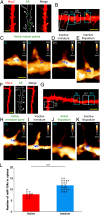Nanoscale imaging reveals miRNA-mediated control of functional states of dendritic spines
- PMID: 31019087
- PMCID: PMC6511049
- DOI: 10.1073/pnas.1819374116
Nanoscale imaging reveals miRNA-mediated control of functional states of dendritic spines
Abstract
Dendritic spines are major loci of excitatory inputs and undergo activity-dependent structural changes that contribute to synaptic plasticity and memory formation. Despite the existence of various classification types of spines, how they arise and which molecular components trigger their structural plasticity remain elusive. microRNAs (miRNAs) have emerged as critical regulators of synapse development and plasticity via their control of gene expression. Brain-specific miR-134s likely regulate the morphological maturation of spines, but their subcellular distributions and functional impacts have rarely been assessed. Here, we exploited atomic force microscopy to visualize in situ miR-134s, which indicated that they are mainly distributed at nearby dendritic shafts and necks of spines. The abundance of miR-134s varied between morphologically and functionally distinct spine types, and their amounts were inversely correlated with their postulated maturation stages. Moreover, spines exhibited reduced contents of miR-134s when selectively stimulated with beads containing brain-derived neurotropic factor (BDNF). Taken together, in situ visualizations of miRNAs provided unprecedented insights into the "inverse synaptic-tagging" roles of miR-134s that are selective to inactive/irrelevant synapses and potentially a molecular means for modifying synaptic connectivity via structural alteration.
Keywords: atomic force microscopy; dendritic spines; force mapping; microRNAs; structural plasticity.
Conflict of interest statement
The authors declare no conflict of interest.
Figures





Similar articles
-
AFM Imaging Reveals MicroRNA-132 to be a Positive Regulator of Synaptic Functions.Adv Sci (Weinh). 2024 May;11(17):e2306630. doi: 10.1002/advs.202306630. Epub 2024 Mar 17. Adv Sci (Weinh). 2024. PMID: 38493494 Free PMC article.
-
A brain-specific microRNA regulates dendritic spine development.Nature. 2006 Jan 19;439(7074):283-9. doi: 10.1038/nature04367. Nature. 2006. PMID: 16421561
-
Direct current stimulation-induced synaptic plasticity in the sensorimotor cortex: structure follows function.Brain Stimul. 2020 Jan-Feb;13(1):80-88. doi: 10.1016/j.brs.2019.07.026. Epub 2019 Aug 1. Brain Stimul. 2020. PMID: 31405790
-
Structural modulation of dendritic spines during synaptic plasticity.Neuroscientist. 2012 Aug;18(4):326-41. doi: 10.1177/1073858411407206. Epub 2011 Jun 13. Neuroscientist. 2012. PMID: 21670426 Review.
-
BDNF signaling during the lifetime of dendritic spines.Cell Tissue Res. 2020 Oct;382(1):185-199. doi: 10.1007/s00441-020-03226-5. Epub 2020 Jun 14. Cell Tissue Res. 2020. PMID: 32537724 Free PMC article. Review.
Cited by
-
miRNA-Dependent Control of Homeostatic Plasticity in Neurons.Front Cell Neurosci. 2019 Dec 5;13:536. doi: 10.3389/fncel.2019.00536. eCollection 2019. Front Cell Neurosci. 2019. PMID: 31866828 Free PMC article. Review.
-
Non-coding RNA in alcohol use disorder by affecting synaptic plasticity.Exp Brain Res. 2022 Feb;240(2):365-379. doi: 10.1007/s00221-022-06305-x. Epub 2022 Jan 13. Exp Brain Res. 2022. PMID: 35028694 Review.
-
miRNA: local guardians of presynaptic function in plasticity and disease.RNA Biol. 2021 Jul;18(7):1014-1024. doi: 10.1080/15476286.2020.1871214. Epub 2021 Feb 15. RNA Biol. 2021. PMID: 33586621 Free PMC article. Review.
-
Mir324 knockout regulates the structure of dendritic spines and impairs hippocampal long-term potentiation.Sci Rep. 2023 Dec 8;13(1):21919. doi: 10.1038/s41598-023-49134-w. Sci Rep. 2023. PMID: 38082035 Free PMC article.
-
The Subcortical-Allocortical- Neocortical continuum for the Emergence and Morphological Heterogeneity of Pyramidal Neurons in the Human Brain.Front Synaptic Neurosci. 2021 Mar 11;13:616607. doi: 10.3389/fnsyn.2021.616607. eCollection 2021. Front Synaptic Neurosci. 2021. PMID: 33776739 Free PMC article.
References
-
- Hering H, Sheng M. Dendritic spines: Structure, dynamics and regulation. Nat Rev Neurosci. 2001;2:880–888. - PubMed
Publication types
MeSH terms
Substances
LinkOut - more resources
Full Text Sources

